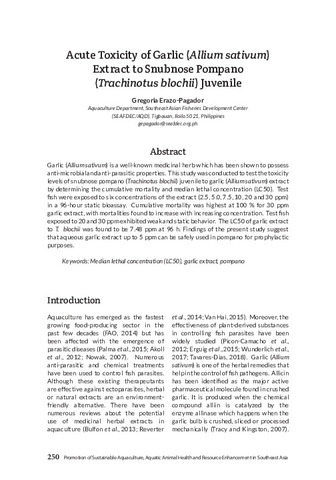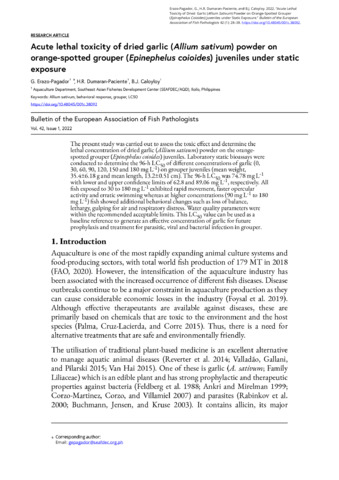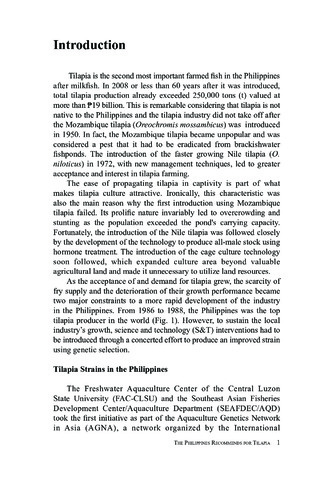| dc.contributor.author | Erazo-Pagador, Gregoria | |
| dc.contributor.author | Dumaran-Paciente, Haydee Rose | |
| dc.contributor.author | Caloyloy, Blan Jericho | |
| dc.date.accessioned | 2023-06-14T05:06:14Z | |
| dc.date.available | 2023-06-14T05:06:14Z | |
| dc.date.issued | 2023-06 | |
| dc.identifier.citation | Erazo-Pagador, G., Dumaran-Paciente, H. R., & Caloyloy, B. J. (2023). Behavior changes and LC50 of dried garlic (Allium sativum) acute toxicity in Nile tilapia (Oreochromis niloticus) juvenile. Philippine Agricultural Scientist, 106(2), 215-220. | en |
| dc.identifier.issn | 0031-7454 | |
| dc.identifier.uri | http://hdl.handle.net/10862/6448 | |
| dc.description.abstract | Plant-based compounds are emerging substitutes for chemical treatments in aquaculture since they are known to cause less harm to both the environment and its organisms. Garlic (Allium sativum) is a popular herb that has a broad range of uses, especially in the control and treatment of bacterial and parasitic diseases. However, its toxicity to tilapia is not well-studied. Hence, this study was conducted to test the toxicity levels of garlic powder in juvenile Nile tilapia (Oreochromis niloticus) by determining the cumulative mortality and median lethal concentration (LC50). Test fish were exposed through immersion in 6 concentrations (150, 200, 250, 300, 350, and 400 mg L-1) of garlic powder with 25% allicin and a control in 96 h static bioassay. Within 24 h, test fish exposed to 250 mg L-1 garlic and above, exhibited abnormal behaviors such as lethargy, gasping for air, and weak responses to environmental stimuli. Cumulative mortality was highest at 100% in 400 mg L-1 garlic at 48 h. Mortalities were dependent on the concentration and duration of exposure. The 96 h LC50 of garlic powder to O. niloticus is 225.86 mg L-1 with lower and upper confidence limits of 210.37 and 242.50 mg L-1, respectively at 27°C. | en |
| dc.description.sponsorship | The authors thank the Government of Japan Trust Fund (Study Code: 8400-T-RD-FH0215) for funding this study. We are grateful to Dr. Evelyn Grace Ayson and Mr. Peter Palma for their valuable comments on the manuscript and technical assistance of Mr. Elvis Biñas. | en |
| dc.language.iso | en | en |
| dc.publisher | College of Agriculture and Food Science, University of the Philippines Los Baños | en |
| dc.subject | garlic | en |
| dc.subject | Allium sativum | en |
| dc.subject | tilapia | en |
| dc.subject | Oreochromis niloticus | en |
| dc.title | Behavior changes and \(\mathsf{LC_{50}}\) of dried garlic (Allium sativum) acute toxicity in Nile tilapia (Oreochromis niloticus) juvenile | en |
| dc.title.alternative | Behavior changes and LC50 of dried garlic (Allium sativum) acute toxicity in Nile tilapia (Oreochromis niloticus) juvenile | en |
| dc.type | Article | en |
| dc.citation.volume | 106 | en |
| dc.citation.issue | 2 | en |
| dc.citation.spage | 215 | en |
| dc.citation.epage | 220 | en |
| dc.citation.journalTitle | Philippine Agricultural Scientist | en |
| dc.subject.asfa | behavioural responses | en |
| dc.subject.asfa | mortality | en |
| dc.subject.asfa | toxicity tests | en |
| dc.subject.asfa | tilapia culture | en |
| dc.subject.scientificName | Allium sativum | en |
| dc.subject.scientificName | Oreochromis niloticus | en |
| local.subject | behavioral response | en |
| local.subject | cumulative mortality | en |
| local.subject | garlic | en |
| local.subject | tilapia | en |
| local.subject | median lethal concentration (LC50) | en |
| local.subject | 96 h static bioassay | en |



